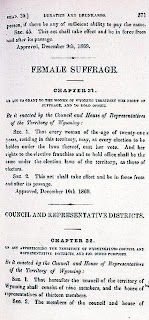 |
| Fort Lupton Replica of the 1840s trade center north of Denver |
In the gallery I focused the class’ attention on the subject at hand: the history of our area, the St. Vrain Valley. I explained that the name of our valley, the river that flows through it, and the local school district all hark back to buffalo robe trader Ceran St. Vrain. He, along with William and Charles Bent, operated the most successful trading company on the plains in the 1830s and ‘40s. In 1833 they built Bent’s Fort, on the Santa Fe Trail, and in 1837 Ceran St. Vrain supervised the construction of a second “adobe castle,” this one on the South Platte River, not far from our museum.
It’s a good sign when kids catch the contemporary tie-ins to history so I was glad to see the group make the connection with Mr. St. Vrain. Then a hand went up. It belonged to the young man so earnestly searching for a dinosaur earlier. “You mean...” he started hesitantly, “they named him after a river?”
 |
| Powder horns and leather haversacks in the trade room at Fort Lupton |
What I found was the spirit of American cutthroat competition. Two years after Bent's Fort was built on the Arkansas River, entrepreneurs Louis Vasquez and Andrew Sublette went north, in 1835, to the Platte and began their own adobe trading fort near present-day Platteville. They called it Fort Vasquez. Today the Fort Vasquez historical site and a small museum are managed by the Colorado Historical Society.
In 1837 a man named Lancaster P. Lupton erected his own adobe trading fort...just seven miles south of Vasquez's namesake! Fort Lupton is now being replicated near its original site by the South Platte Valley Historical Society. Though SPVHS volunteers are not employing the 19th Century construction techniques used by the National Park Service to reconstruct Bent's Fort, their final product will be a fine evocation of Colorado's early history.
 |
| Traps at Fort Lupton |
Business must have been brisk on the South Platte in 1837. That same year a third trading fort - this one probably a wooden stockade - was built by Peter A. Sarpy and Henry Fraeb. Called Fort Jackson, it was half way between forts Vasquez and Lupton. Location, location, location!!!
The three new forts represented a challenge the Bent brothers and Ceran St. Vrain evidently could not ignore, and, not to be outdone, they joined the building frenzy of 1837. St. Vrain himself supervised construction of a fourth Platte River castle, a few miles north of the upstart contenders. The name of Ceran's trading post evolved for a few years but soon became known widely as Fort St. Vrain.
Ceran left his youngest brother, Marcellin, in charge, and the Bent-St. Vrain brand whomped on its competitors. Within a year the Bent & St. Vrain Company bought - and burned - Fort Jackson. Fort Vasquez changed hands once and then was abandoned. In 1844 Fort Lupton was shuttered by its financial backers. (I joke that Bent's Fort was the WalMart of its day. The analogy seems complete to me now, since that merchandising giant too is often the death knell for local businesses.)
By 1845 the entire buffalo robe trade was drying up. The era of good feelings between whites and Native Americans was dying. Fort St. Vrain slipped into a state of neglect. When Francis Parkman saw it in 1846, the building was already "miserably dilapidated." But according to Halaas and Masich in Halfbreed, their great biography of George Bent, in 1849 William Bent was still able to make the fort liveable, compelled as he was to flee with his family to the crumbling Fort St. Vrain to escape the cholera epidemic wiping out half of the Cheyenne Indians on the southern plains.
I'd you love to time travel back to the 1840s. Comparison shopping in the adobe castles along the South Platte River would have been quite an adventure.
Here are some book titles and links for further reading:
Bent's Fort: Crossroads of Cultures on the Santa Fe Trail by Melvin Bacon and Daniel Blegen
Bent's Fort by David Lavender
Halfbreed: The Remarkable True Story of George Bent by David Fridtjof Halaas & Andrew E. Masich
The Oregon Trail by Francis Parkman
Links: Fort Vasquez Fort Lupton National Park Service
Bent's Fort by David Lavender
Halfbreed: The Remarkable True Story of George Bent by David Fridtjof Halaas & Andrew E. Masich
The Oregon Trail by Francis Parkman
Links: Fort Vasquez Fort Lupton National Park Service


